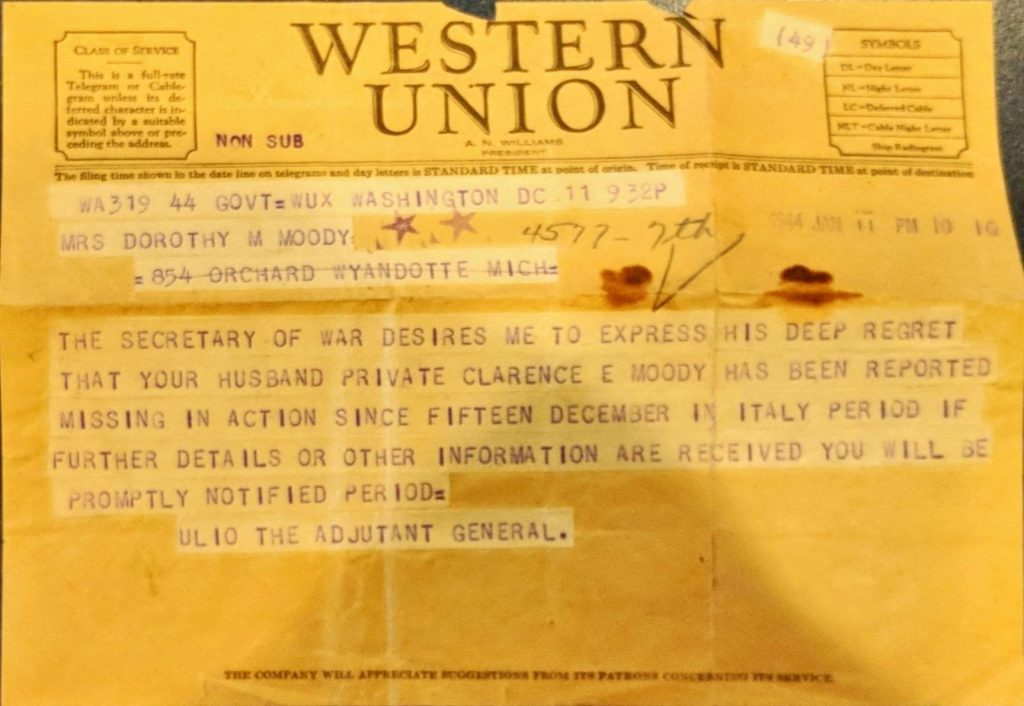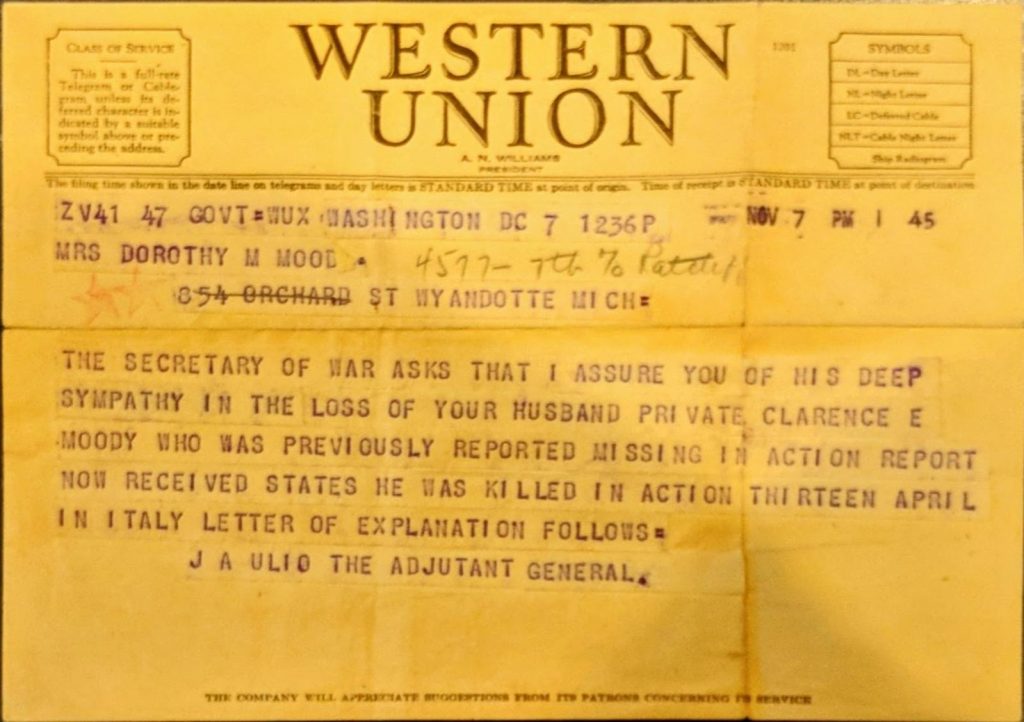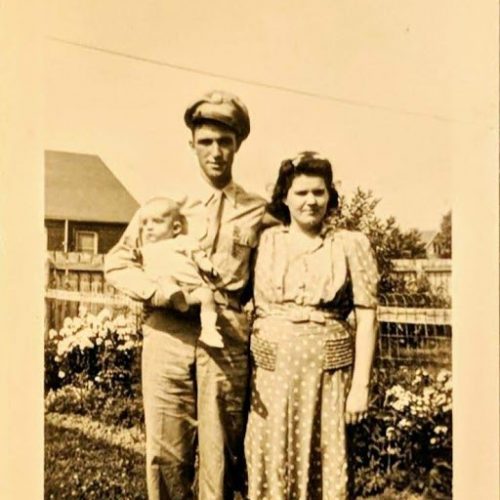Historical Account of the Massacre at Montebuono on the 13th April 1944 by Janet Kinrade Dethick
Historical Account of the Massacre at Montebuono on 13th April 1944
by Janet Kinrade Dethick
According to the Report dated October 3rd, 1944 of the 3044th QM Graves Registration Company1 the following American soldiers were shot by German forces on April 13th, 1944, at the Hermitage of San Benedetto, near Montebuono, Province of Rieti, Italy:
34625098 Private Robert C. Carnathan 36590875 Private Clarence E. Moody
35637523 Private. Woodrow W. Thomas 8006151 Corporal Paul H. Valdez.
33183989 Private First Class Charles Dyda 37354115 Private First Class. Ben Espinosa
37353883 Private First Class George W. Kerr 33678141 Private Robert J. Rankl
ALL EIGHT WERE ESCAPED PRISONERS OF WAR
Five were from 157th Regiment, 45th Infantry Division.
34625098 Pvt. Robert C. Carnathan. 36590875 Pvt. Clarence E. Moody, 35637523 Pvt. Woodrow W. Thomas and 8006151 Cpl. Paul H. Valdez belonged to 3 Platoon, C Company and were taken prisoner near Venafro to the east of Cassino on December 15th, 1943. How they came to be captured is described by their platoon leader 20838320 S/Sergeant Richard A. Morris in his unpublished memoirs ‘Escape’:
At intervals all day long the machine gun would rake the ravine just a few inches away from the men standing erect and hugging whatever protection the gully wall offered. As the gloom of night deepened, the Germans began lobbing grenades down on the floor of the stream bed. The men’s erect position made them vulnerable to the grenades. Many suffered minor wounds from the grenade fragments, the machine gun bullets, or from rock chips of the wall where bullets struck…I decided to surrender what remained of my platoon. Shouting, ‘Kamerad, kaput’, I made my way up the fissure toward the German position. A short German soldier, waving a sub-machine gun, danced around me as he chanted in fairly good English, ‘For you the war is over.’ He appeared to be no more than 14. Some 12 men from my platoon struggled up from the bottom of the ravine.
33183989 Pfc. Charles Dyda of G Company was captured in the same area a day later.
At the same time that 45 Division was launching its attack the tanks of 753th Tank Battalion were trying to take the little town of San Pietro Infine and it was during this action that 37354115 Pfc. Ben Espinosa and 37353883 Pfc. George W. Kerr were captured.
33678141 Pvt. Robert J. Rankl of A Company, 135th Regiment, 34th Division had been captured some days earlier on Monte Pantano near to where 45th Division had been in action.
Details of the battles can be found in Fifth Army at the Winter Line 15 November 1943 -15 January 1944, published by the Center of Military History United States Army, Washington, D.C., 1990.
Prisoners of the occupying German forces, all eight men were taken initially to some disused Carabinieri (military police) barracks in the town of Frosinone. From there on January 4th they were transferred to Prisoner of War Camp no. 54 Fara in Sabina, a camp set up by the Italian War ministry in the summer of 1942 to house Allied prisoners captured in North Africa. After the Armistice of September 8th, 1943, agreed between the Italian Government and the Allied Powers, it was used by the occupying German forces as a transit camp for men taken prisoner on Italian soil.
On January 26th all the occupants of the camp – between 800 and 1000 – were entrained in cattle trucks for the Stalags – prisoner of war camps in Germany or the German occupied territories of Austria and Poland. On January 28th, as the convoy was crossing a bridge over the river Paglia near to Allerona to the north of Orvieto it was bombed and machine-gunned by aircraft from 442th Squadron, 320th Bomb Group, United States Army Air Force, whose mission for the day was to destroy the bridge, not the train. A. large number of casualties resulted.
All the Americans who had been taken prisoner were in the first wagon and most of them escaped from the wreckage unhurt.
The eight men killed at Montebuono stayed together in one large group, and a month or so later met up with evader 14067688 Sgt. Milton D. Lanier, 444th Bomb Squadron, 320th Bomb Group, whose plane had been shot down on January 21st over Orvieto Bridge South. The official inquiry into their deaths reported Sgt. Lanier’s testimony, which stated that whilst on the run he had met eight enlisted men, ranks unknown, and during the one day that he was in their company they had exchanged names and serial numbers.
THE ROUND-UP AND SUMMARY EXECUTION
Between March 29th and May 1st, 1944 the German occupying forces and local fascists were determined to round up those draft dodgers and escaped prisoners of war who were swelling the ranks of the partisans. In mid-April two special units went into action on the border between the two Italian regions of Umbria and Lazio. On April 13th one them, the I./SS-Polizei-Regiment-20, were to sent to clear the area around the Hermitage of San Benedetto in the hills above Montebuono.
Their Kriegstagebuch (War Diary) has the following entry:
At S. Benedetto a group of Americans in civilian clothes, made up of 1 officer and 7 non commissioned officers or ordinary ranks, were exterminated.
THE TEMPORARY BURIAL
Father Antonio Piccarozzi, the parish priest of Montebuono, saw to recovering the dead. With the help of some local men he collected the bodies and buried them close to the little church attached to the hermitage.7 They were later transferred to the civil cemetery of Montebuono.
THE WORD SPREADS
A British artilleryman, 926821 Gunner John Mallen, an escaped prisoner of war in hiding in Montebuono, heard the shots fired. He witnessed both the German retreat from Montebuono and the arrival of the British on June 12th, and during the interrogation which preceded his repatriation he reported the shootings, which he said were subsequently investigated as a war crime.
THE OFFICIAL ENQUIRY
When the American investigating party arrived at Montebuono they were directed to Father Antonio Piccarozzi. Father Piccarozzi certified that Ben Espinosa was buried in the civil cemetery in grave #3 and Robert Rankl in grave #8, the latter identified by a letter found on the body. He further stated that three of the men had been found with identification tags, which had been sent, together with Rankl’s letter and the men’s personal effects, to the Vatican. He also had a list of names which tallied with that produced by Sgt. Lanier.
After verifying their date of death as being April 13th, 1944, on September 28th the 3044th QM Graves Company removed the soldiers’ remains from the cemetery in Montebuono and re-interred them in the U.S. Military Cemetery at Nettuno. The details on the burial reports were passed on to the USA section of the Mediterranean Theater of Operations so that an attempt could be made to identify each of the victims, the findings of which were dated 3 October 1944.
As has been said, the burial places of Pfc. Ben Espinosa and Pvt. Robert J. Rankl were known to the priest. Dental charts were available for five of the other six which allowed them to be identified, and the sixth, Charles Dyda, was identified by deduction.
RESULTS OF THE INVESTIGATION
Here is part of the final report:
The status of the 8 enlisted men was verified as KIA (killed in action) 13 April 1944. AGO (Advocate General’s Office) death reports are in file of this office for all except Pfc Charles Dyda, 33183989. Duplicate copies of said report have been requested from Certification section, AGO, for this deceased. Available dental charts (WD Forms 79 or induction records) for the 8 have been compared with the tooth charts submitted for the unknowns with the following favourable results:
Through the favourable comparison of tooth charts and the statements made by Father Antonio Piccarozzi, the identity of subject Unknowns, interred in the U.S. Military Cemetery Nettuno, has been established as follows:
Case Grave Identified as
Espinosa, Ben (indicated as) 50690 6183 ESPINOSA, Ben J. 37354115 Pfc.
Rankl, Robert J. (indicated as ) 50691 6191 RANKL, Robert J. 33678141 Pvt.
Unknown x-562 50692 6181 THOMAS, Woodrow W. 35637423 Pvt.
Unknown x-563 50693 6182 VALDEZ, Paul H. 38006151 Cpl.
Unknown x-564 50694 6184 KERR George W. 37533883 Pfc.
Unknown x-565 50695 6185 DYDA, Charles 33183989 Pfc.
Unknown x-566 50696 6186 MOODY Clarence E. 36590875 Pvt.
Unknown x-567 50697 6187 CARNATHAN Robert C. 34625098 Pvt.
The ages, places of birth and final resting places can be found on this chart:
Rank Name & Surname Company & Regiment or Battalion & Division Date/Place of capture1943 Place and year of birth Final burial place.
Pvt Robert C.Carnathan C Coy, 157 Infantry Regt.,45 Infantry Div. 15 December near Venafro Union County Mississippi 1923 Mt Gilead Cemetery
Union County, Mssissippi, USA.
Pfc Charles Dyda G Coy, 157 Infantry Regt.,45 Infantry Div. 16 December near Venafro Cambria County Pennsylvania 1920 St. Vladamir Cemetery, Johnstown, Cambria County Pennsylvania, USA.
Pfc Ben Espinosa 753 Tank Battalion 15 December near San Pietro Saguache County Colorado 1920 Nettuno, Italy.
Pfc George W. Kerr 753 Tank Battalion 15 December near San Pietro Canyon County Idaho 1920 Arlington National Cemetery,
Arlington County, Virginia, USA
Pvt Clarence E. Moody C Coy, 157 Infantry Regt.,45 Infantry Div. 15 December near Venafro Raleigh County
West Virginia 1924 Grafton National Cemetery, Taylor County, West Virginia, USA.
Pvt Robert J. Rankl A Coy, 135 Inf. Regt. 34 Infantry Div. Early December near Venafro Pittsburgh Pennsylvania 1924 St. Peter’s Cemetery,
Mount Oliver Allegheny County, Pennsylvania, USA.
Pvt Woodrow W. Thomas C Coy, 157 Infantry Regt.,45 Infantry Div. 15 December near Venafro McDowell County West Virginia 1912 Nettuno, Italy.
Cpl Paul H. Valdez C Coy, 157 Infantry Regt.,45 Infantry Div. 15 December near Venafro Las Animas County Colorado 1918 Trinidad Catholic Cemetery, Las Animas County, Colorado, USA
FAMILIES BACK HOME
To date information has been obtained regarding five of the above soldiers –Pfc. Dyda, Pfc. Espinosa, Pvt. Rankl, Pvt. Thomas and Pvt. Clarence E. Moody.
Pvt. Robert Rankl’s Individual-Deceased-Personnel-File is available on line. It is interesting to note from his mother’s letter to the Office of Graves Registration, Washington, dated April 5th, 1946, that in a response to an earlier letter written to his commanding officer she had been informed that he had been reported missing in action in the latter part of 1943. However, another communication from the adjutant general’s office, dated 9 November 1944, gave the missing date as 10 January 1944. For the sake of this account his commanding officer’s version has been taken as correct. When she wrote the letter dated April 5th, 1946, Pvt. Rankl’s mother had still not been informed of the circumstances of her son’s death. It will be noted that the official inquiry into the shootings did not report until April 16th 1946.
Clarence E. Moody’s grandson, Gary F. Moody, has sent in copies of all the official documentation relating to his grandfather.
Sources
Military documents
Kriegstagebuch A.O.K.14 Bundesarchiv Militararchiv, Freiburg.
45th Infantry Division, 157th Regiment, C Company, Morning Report, 15 December 43
Unpublished memoirs
Kurzhal, Russel Eugene
Morris, Richard A.
Books
Cipolloni Antonio, La guerra in Sabina dall’8 settembre 1943 al 12 giugno 1944, Arti Grafiche Celori, Terni, 2011.
Climinti Enzo, Il gruppo di combattimento Schanze, Settimo Sigillo, Roma, 2006.
Tomassini Giov. Battista, Il Ponte, Vetrya SpA. 2012.
Fifth Army at the Winter Line 15 November 1943 -15 January 1944, Center of Military History United States Army, Washington, D.C., 1990
THE MEN AND THEIR FAMILIES
Deceased personnel files have been found in the American archives regarding Charles Dyda, Robert J. Rankl, Ben Espinosa and Woodrow W. Thomas and are in the possession of Paul Haskell.
Gary F. Moody, the grandson of Clarence E. Moody, has contacted the organisers with documents and photographs relating to his grandfather.
Above: Moody with his wife Dorothy and son Gary


The above photographs were provided by Gary F. Moody.
8 US servicemen killed during World War II honoured in Italy on 75th anniversary.
Seventy five years after eight U.S. servicemen were summarily shot at a hermitage on the top of a mount overlooking the Italian village of Montebuono during World War II local Italians and foreign residents came together to honour them.
Harry Shindler MBE attend the 75th anniversary commemorations. The local village had organised a small convoy of four-wheel drive vehicles to transport around 80 participants up to the hermitage. They included local dignitaries, and NATO representatives from Canada, USA and the UK. During the event the town band played both the American and Italian national anthems and a new plaque was unveiled and wreaths were laid. The eight service men had been on the run for over two months after their escape.
The town still remembers the soldiers every year and makes an annual pilgrimage to the hermitage. Many in the town still remember their parents giving the airmen bread and other food and they recall hearing the shots form the hermitage that morning. Nello Lucchetti who was just 13 at the time, recalls climbing up to the hermitage after hearing the shots and seeing the eight bodies laying in a line on the ground, he is now in his late 80’s.
Harry Shindler MBE recalling the immense kindness of the Italians who helped the allied soldiers. Told the locals after the ceremony, “The war would have been longer, more horrible, without the partisan help that liberated Italy. If we really want to remember these eight soldiers, we must explain what war was, not just how horrible it was – the deaths – but about the loss of freedom, how one couldn’t talk freely then and how we must now work for peace and freedom. We have to make sure that our children will not have to do what we had to do. When the 1st World War ended, the whole world said, ‘Never again’, but in only 20 years they were involved in another war. Adding that everyone should be indebted to the eight servicemen and the “thousands of young men who died when they came to Italy to remove a regime. We won, and so democracy and freedom returned to Italy. And when we came to Italy, the Italians, good people, helped us’
My thanks to ‘Our Man in Italy’ Harry Shindler MBE for sending me the published article by Phoebe Natanson of ABC News which is the basis for the above.
We must never forget.
Robin Hollamby National Vice Chairman

